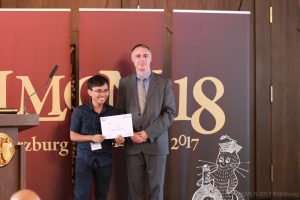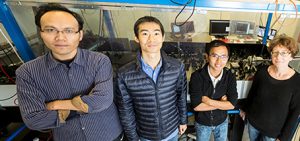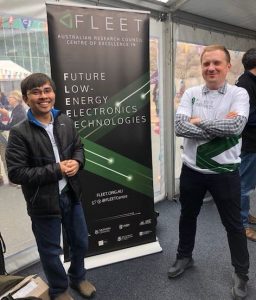FLEET’s Eli Estrecho recently finished his PhD, and is now a postdoctoral researcher, working with Professor Elena Ostrovskaya in the Polariton-BEC Research Group, Australian National University.
We asked Eli some questions about his research, how he got into physics, and the thrill of fundamental discoveries.

“It fascinates me that a few fundamental laws of physics can, in principle, explain everything around us.”
FLEET postdoc Eliezer Estrecho
Q: Tell me about your research at ANU
EE: I study hybrid particles of light and matter called exciton-polaritons (or simply polaritons). These are created when light strongly interacts with excitons or bound pairs of electrons and holes in a semiconductor.
Q: That’s fascinating, but pretty complex. How do you describe it to non-physicists?
EE: Polaritons are similar to hybrid animals like wolphins (bottlenose dolphin + false killer whale, which is also a dolphin), ligers (lion + tiger), and mules (donkey + horse).
But unlike in the animal world where the parent animals belong to the same taxonomic family, the parent particles of polaritons are quite the opposite: light doesn’t occupy space nor have mass, but matter does.
Q: Why is this awesome?
EE: The fact that we mix two seemingly opposite types of particles (photons for light and excitons for matter) makes polaritons fun to work with.
It also takes advantage of each type of particle’s properties:
Light is fast (useful for communication) but light particles hardly interact with each other, so it’s not much use for doing ‘work’, while matter is slow but matter particles constantly bump into each other (which means they’re useful for computing).
Polaritons have the best of both worlds: light mass and strong interactions.
This enables expression of quantum phenomena, like superfluidity, at ambient conditions. Similarly to superconductors, superfluids flow without resistance but are typically limited to low temperatures.
Polaritons can possibly permit a zero-resistance flow of electrons and holes, which could have rich applications for future low-energy electronics. However, what I really find interesting about polaritons is the rich physics you uncover using a relatively easy experiment.
Q: How did you get into physics?
EE: As a child, I found science interesting because it explained how nature works.
Among the sciences, I found physics to be the simplest yet the most general of all. It fascinates me that a few fundamental laws of physics can, in principle, explain everything around us. And now, after almost 15 years, I am still excited by the things I learn and unlearn in this field.
Q: What’s next for you on this project?
EE: We are now looking at high-density condensates to see interesting effects that have not been demonstrated before.
With the help of our collaborators, we are also aiming to create polariton condensates using 2D materials, specifically transition metal dichalcogenides (TMDs). Unlike the traditional GaAs semiconductor that I have used in my PhD, the polaritons in TMDs are stable at room temperature so it is promising for both applications and fundamental research.
Q: What have been the most exciting discoveries for you on this project?
EE: For me, the two highlights have been (1) non-Hermitian nature of polaritons, and (2) ‘snapshot’ (single-shot) imaging.
Both of these were advances that were either thought of as unimportant or considered impossible.
While the non-Hermitian physics of polaritons was previously known, we were the first group to provide evidence of its relevance to this field by showing features not possible to see in ordinary (Hermitian) physics.
On the other hand, imaging a single realisation of a polariton condensate was thought impossible due to lack of density, but we still tried, and succeeded. And we found interesting effects that had never been observed in experiments before.
Q: Who do you work with?
EE: My supervisors are CI Elena Ostrovskaya and Prof. Andrew Truscott, and my colleagues are Maryam Boozjhamer, Maciej Piczierka and Matthias Wurdack.
We also collaborate with FLEET CI Qiaoliang’s group at Monash University, and AI Larry Lu’s group at ANU.
Q: What’s good about working within FLEET?
EE: The pool of available resources and expertise, and the drive to work towards a common goal using different pathways.
Previously, most of my group’s collaborators were overseas based. There just weren’t that many people working in our field here in Australia. So we’re really enjoying working with a wider group of Australian collaborators.
FLEET also invests in training its students and early career researchers, which is useful for my future career.
Q: What’s your hopes for your work within FLEET?
EE: I hope we will achieve our goals, especially on polaritons.
And in the process of reaching our objectives, I am hopeful we will also discover a lot of interesting things – which is actually the fun part.
For more information:
- FLEET Research theme 2 news
- Polariton BEC Research Group at ANU polaritonbec.org
- @FLEETCentre





